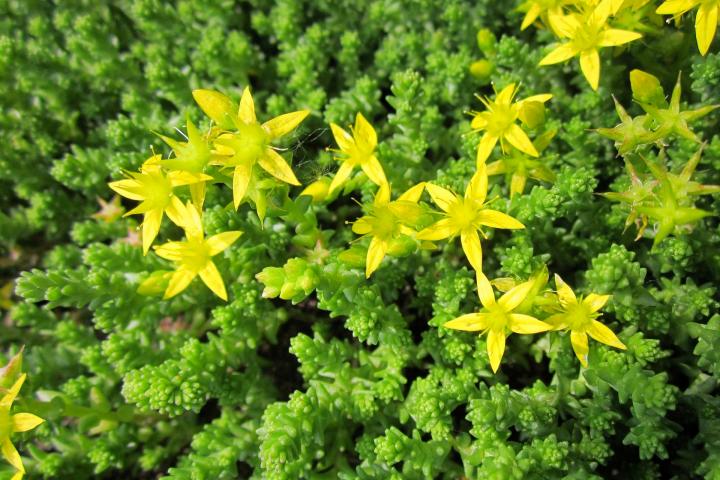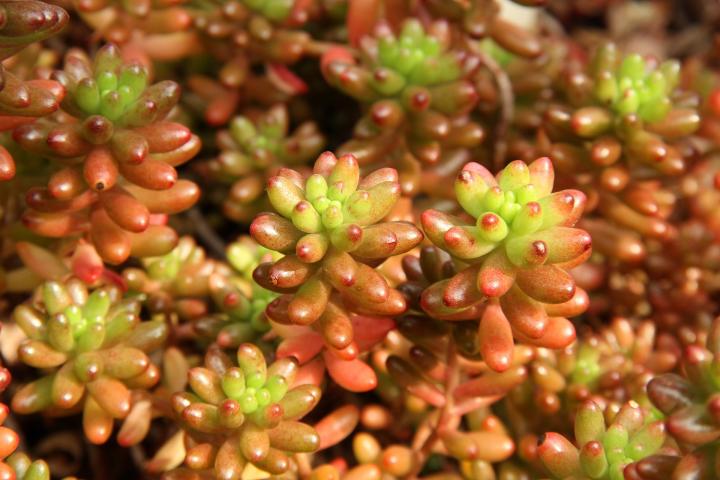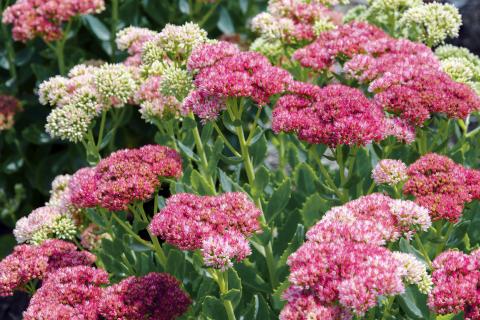Sedum is a perennial plant with thick, succulent leaves, fleshy stems, and clusters of star-shaped flowers. Here’s how to grow sedum in your garden!
About Sedum
There are many, many different varieties and species of sedum—also called “stonecrop”—which makes them suitable for use in almost any garden design. They’re hardy, easy to care for, and beloved by pollinators, too!
We like to divide sedum into two main categories based on the plants’ growth habits: low-growing sedum and upright sedum.
- Low–growing sedum spreads along the ground, reaching only a few inches (or less) in height. This makes them perfect for use as a ground cover along paths, in rock gardens, or cascading down a stone wall.
- Upright sedum tends to form tall, upright clumps that produce a tight mass of tiny reddish-pink flowers. Their height and attractive flowers make them good candidates for border gardens or pollinator gardens. A few years ago, upright sedum was reclassified to another genus, Hylotelephium, but it is still commonly referred to as a “sedum.”
Planting
When to Plant Sedum
- Sedum is usually bought in plugs or pots and transplanted into the garden. The best time to plant sedum is in the spring—after the threat of frost but before the heat of summer kicks in.
- Plant sedum seeds in early spring in well-drained, average to rich soil. (Learn more about soil amendments and preparing soil for planting.)

Choosing and Preparing a Planting Site
- Low-growing and vigorous species will tolerate partial shade, but most sedum do best in full sun.
- If growing sedum in an area that gets long, cold winters (Zone 5 and colder), plant in full sun to improve overwintering capability.
- Sedum grows well in poor, sandy soils that drain well. It is very susceptible to root rot if grown in soil that holds too much moisture.
- Overly-rich soil can encourage leggy growth, which can result in upright sedum varieties becoming top heavy when they bloom.
- Sedum’s succulent foliage can make it a target for deer, chipmunks, and other garden visitors to nibble on.
How to Plant Sedum
- Space plants between 6 inches and 2 feet apart, depending on the variety. Low-growing sedums will readily spread to fill any gaps, while upright sedums tend to stay more compact.
- Planting full plants or divisions: Dig a hole deep enough so that the top of the root ball is level with the surface of the soil, then place the plant in the hole and fill in around it. Be careful not to bury the stems of upright sedum especially, as this can lead to rot.
- Planting cuttings: Like other succulents, sedum can be readily propagated via cuttings. Simply place the cut end into soil and the cutting should have no trouble rooting under proper lighting and watering conditions.
Growing
How to Grow Sedum
- Once established, sedum plants require little care. During the summer, check your plants regularly to make sure they are not too dry and water (sparingly) if needed. As long as your area gets rain every couple of weeks at the least, sedum shouldn’t need any extra watering.
- After flowering, cut back the plants to maintain their shape or contain them in one area.
- Tip: For added winter interest, leave the flowers of upright sedum alone after they bloom. They will form attractive seed heads.
- Remember to divide your plants in the spring or fall to control their spread. Throughout the summer, divisions and cuttings root readily.

Pests/Diseases
- Mealybugs
- Scale insects
- Slugs
- Snails
- Birds, deer, squirrels, and voles may nibble on the succulent foliage of sedum.
Recommended Varieties
- Sedum humifusum makes for a great ground cover and has beautiful, bright yellow flowers
- ‘Brilliant’, ‘Autumn Fire’, and ‘Autumn Joy’ upright sedum (Hylotelephium spectabile, aka Sedum spectabile) add bursts of bright pink and magenta to your garden
- ‘Blue Spruce’ (Sedum reflexum) is a low-growing sedum with blue-green, spruce-like foliage and yellow flowers
Flowers
Perennials




